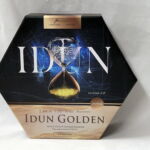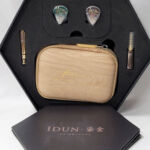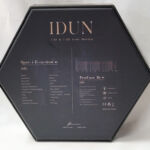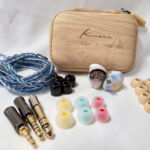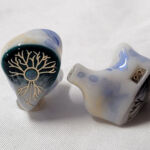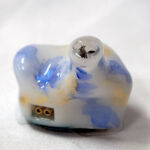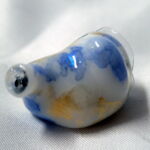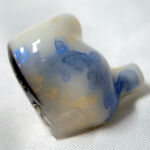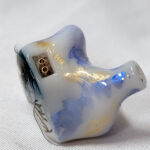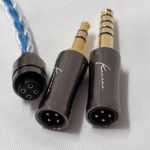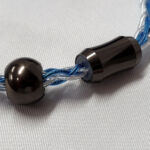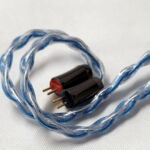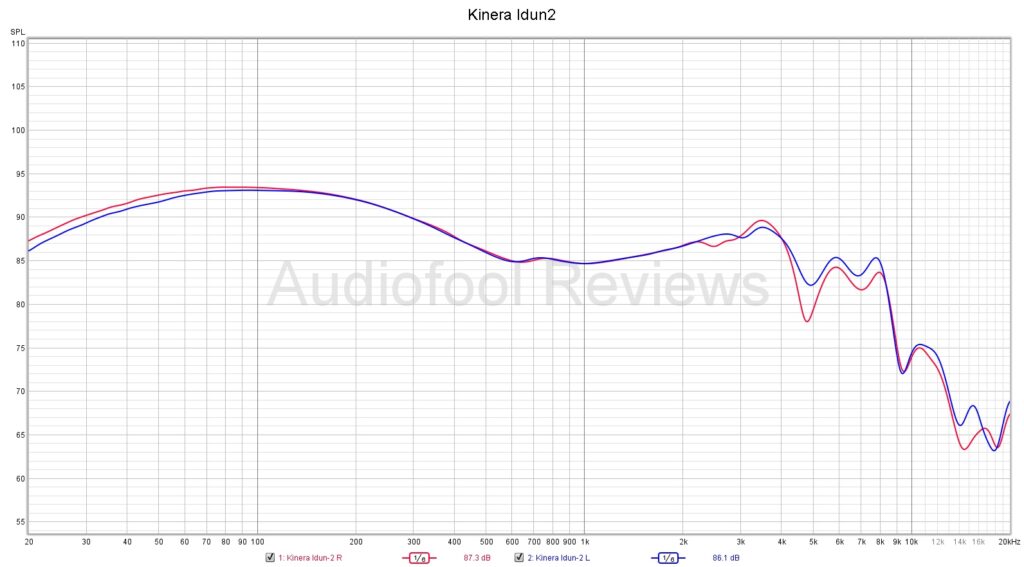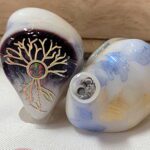Kinera Idun Golden (Idun2)
disclaimer: The Kinera Idun 2 (Golden) was provided for the purpose of review by HiFiGo. I have no financial interest in HiFiGo or Kinera and have received no compensation beyond the in-ear itself for this review. If you have an interest in Kinera products please see their website or follow them on Facebook. To purchase the Kinera Idun 2 see HiFiGo.
Unboxing / Packaging:
Kinera has used hexagonal boxes for some time now as one of its trademarks and the Idun2 does as well as most other recent offerings. I don’t remember the original Idun shipping in a hex-box so think this style of package came along slightly later. The front has a graphic of an hour glass with a tree similar to that shown on the earpieces. The reverse of the box shows the specifications but neither has a photo of the earpieces themselves. Lifting the cover reveals the earpieces, case, and adapters in foam surrounds. Hiding inside the case are the cable, seven sets of silicone tips in two styles and two sets of foams. The cable itself has a 3.5mm and a 4.4mm jack that uses a 4 pin interface to attach to the cable. Somewhat oddly a 3.5 to 6.35mm adapter is provided rather than making a 6.35mm jack for the cable connector.
Build/Fit:
The shells on the idun2 are 3d printed and then hand assembled and hand painted to make each pair unique. Inner shells are a white resin material over a clear nozzle material incuding dual sound bores. Face plates have a gradient from deep blue/black at the top edge slowing fading to white on the lower portion with ta gold tree like pattern overlay-ed. Inner shell shape is the now standard semi-custom of medium size and is painted with blue and gold wisps over the white base resin. I found the Idun2 to sit mostly in the ear and nozzles have a mild forward rake and fairly shallow seating depth making them a comfortable fit but requiring some tip rolling to find a fit that both had a good seal and was comfortable for longer wear. I settled on the 2nd smallest of the tan silicones as the best combination of seal and comfort for me which is a size below what I normally use. The case is well padded and large enough to fit the earpieces and cable but tight enough to keep things in place and prevent a lot of movement inside the case.
Internals:
The Idun2 uses a 7mm dynamic driver with a titanium coated PU diaphragm for the low end, a Knowles 32873 balanced armature for mid-range, and a Kinera customized 30095 balanced armature for highs with a 3-way electronic crossover handling the division between drivers. Nominal impedance is listed as 32Ω with a sensitivity of 112 dB/mW ±2dB (measured at 1kHz) and a rated power handling of 3mW. The Idun2 is easy to drive well and doesn’t need a high potency amplifier to do its best work. I had no problem using the Idun2 from a cellphone or tablet and dongles offered plenty of output to give ample headroom and volume range. The Idun2 scales well qualitatively with better sources and does benefit some from additional potency but the ceiling is fairly low quantitatively.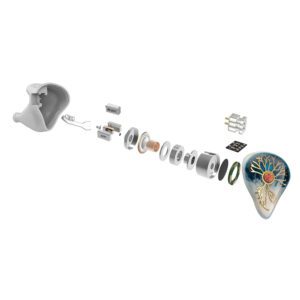
Cable:
The cable is another big upgrade from the original Idun. Both the original and the new version sported silver plated oxygen free copper cores but this new model has a new swap-able jack sytem that the original did not. The cable itself terminates in a 4 pin female connector with an indexing notch to assure proper alignment. the cable connector plugs into a matching receptacle on the jack and locks firmly in place. Jacks in both 3.5mm TRS and 4.4mm Pentaconn are provided so the Idun2 is ready for balanced or single ended use right out of the box. A 6.35 mm adapter is also provided but requires the 3.5mm jack be used as it does not connect directly to the cable terminus. Above the jack the cable is 8 strands (4 in blue casing and 4 in clear) from the jack up to the splitter. The splitter and bead chin-slider match the gun-metal jack housing as do the bi-pin housings at the northern end. Cables exit the splitter as 4 wire braids up to the earhooks and 0.78mm bi-pin connectors. The right connector has a red pin-base for easy indexing and since they seat into recesses in the earpiece body the aesthetic isn’t harmed in the process.
Sound:
Bass:
There is a sub-bass emphasis that centers around the 100Hz mark with distinct roll-off becoming evident below about 40Hz. Those looking for big rumble will be disappointed as the sub-bass has a more natural tuning to it and works well with genres like classic rock and even most classical but will not work as well for electronica, hip-hop, and other genres that make use of heavy sub-bass. Mid-bass begins dropping back from the peak of the sub-bass and falls gently enough to make it hard to realize the drop. What is immediately on display is the mid-bass has good speed and clarity but lacks a bit of note weight at times. The tuning definitely favors clarity over warmth and weight. Bassheads need not look at the Idun Golden as it won’t please them but those looking for an in-ear with a more natural bass presentation will find that while the Idun Golden doesn’t dig as deep or push as much weight and warmth into the mids as some, it does have a more natural tone that is well suited for pieces that rely on piano, acoustic guitar, and vocals as it doesn’t artificially boost the lows and take on an artificial tone. Bob Seger’s “Like a Rock” does a good job of displaying the bass capability and the technicalities of the low end on the Idun Golden.
Mids:
There is no bleed so lower mids are on full display and allow lower vocals to shine, (part of why I picked the Bob Seger example above). Again we see clarity favored over note weight so some recordings sound truly good while others sound a little light in the vocals depending on mastering. Guitar growl is sharp edged with enough detail on display to make the Idun Golden a fun listen with classic rock and at the same time piano has good timbre as well which is a tough mix to get right. Strings have good energy too but, with a slow upper-mid range push, can get a little hot again depending on mastering of the tracks it is fed. Higher vocals cut through the mix well and stand slightly ahead of their lower counterparts again without feeling separated or artificial. Detail in the mids is quite good and again it is obvious that the Kinera engineers chose to emphasize technical ability as the tuning is a bit unforgiving but rewards well mastered tracks with a very natural tonality.
Treble:
Soundstage / Imaging:
Soundstage on the Golden is wider than deep with some height and does pretty well for its price class in the overall. Seating the orchestra shows no major anomalies but does display the orchestra a bit wider and shallower than perhaps absolutely correct. Instrument separation is quite good with no major overlaps in voices and imaging benefits as placements are tight and movements easily tracked around the space. Layering is good as well with little compression noted until tracks get really busy in the low end and even then it is not as pronounced as a lot of the competition.
Thoughts / Conclusion:
Kinera has been steadily adding to its line-up with new models so it was interesting to see them take a step back and revamp an existing model with some of the lessons learned since the original came to market. The Idun was quite popular for its time, but others have since passed it by and while it still has a good bit to offer, it is hard to argue that the price point hasn’t become more crowded since its release and that more recent offerings haven’t upped the ante on what is expected in the $150-200 range. The Idun Golden (2) offers a kit that is at least on par if not better than most and the cable is one of the most well thought out modular systems I’ve encountered to date. I’d love to see them take it a step further and turn the connector on the cable itself 90° so as to shorten the length of connector as this would put less leverage on the port. Maybe v3 right? Sound wise the Golden is at its best for lovers of mids and those listening to string quartet, piano, or fairly simple rock will appreciate it most. Those looking for big bass will find it a bit anemic for their tastes and are likely best served by one of the other offerings in the class. I applaud Kinera for resisting the trend and keeping the Golden more mid-centric and less sub-bass emphasized than a lot of the current offerings as I think the market for a neutral in the price range is under-served.
-
Bass - 6.5/106.5/10
-
Mids - 7.5/107.5/10
-
Treble - 6.5/106.5/10
-
Soundstage - 6.5/106.5/10
-
Imaging - 7/107/10
Summary
Pros: Good build, nice aesthetics, good modular cable system, near neutral tuning
Cons: bass roll-off is fairly high up, treble isn’t even with 3 major regions


